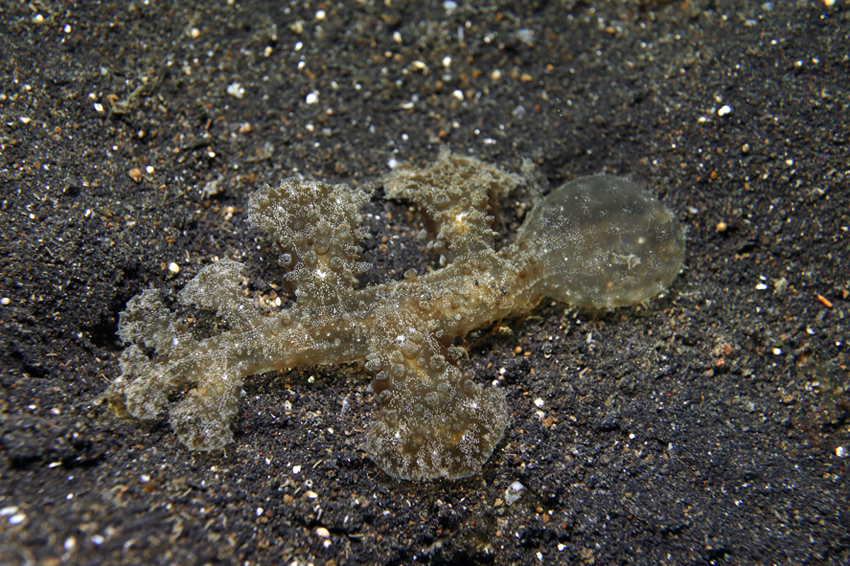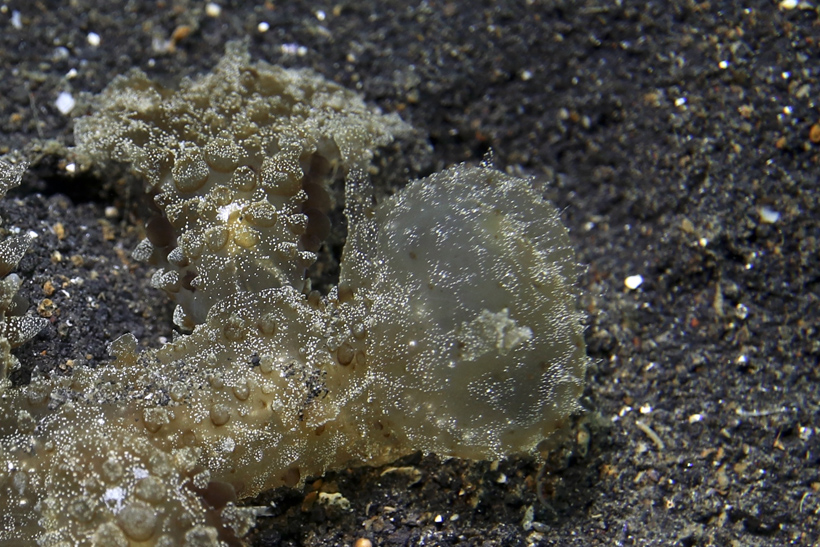Some years ago, still new to the Opithsobranch world, I wrote a post on my old website marveling at an animal called Pteraeolidia ianthina, or the Blue Dragon. It was then my candidate for the strangest looking creature I’d ever seen. No longer. While diving at Lembeh Strait earlier this year, we came across the animal above.
I literally could not work out head from tail. It seemed to be moving mostly with one end in front, but that end had a particularly implausible head candidate, a large flat frying-pan or shovel. That seemed a more likely tail. The rest of the body included several blob-like appendages coming out unpaired, and the whole design had limited rhyme or reason. I was completely at a loss – did not even have a phylum for it. Jim Ris Mamuko, my guide, took out his slate and wrote a word on it: ‘nudibranch.’ Surely not, I thought. But that is what it was, Melibe viridis.*
As a nudibranch, it was a mollusc, and related to familiar slugs and snails. This one was perhaps 3 inches long or so. They can grow a fair bit longer than that. Here is a passage from Bill Rudman’s site:
Their most unique attribute is their method of feeding. They have lost their radular teeth and have developed the oral veil into a large veil or “fish net” which they use to constantly scan the substrate as they crawl along. When the sensitive papillae on the inner edge of the oral veil touch a small crab or crustacean the edge of the veil is rapidly contracted, trapping the prey, which is then ingested. Some species of Melibe, but not this species [viridis], harbour zooxanthellae in their bodies.
That last point is especially interesting. When I singled out the Blue Dragon, years ago, I learned that they are fairly special among nudibranchs as they capture and retain tiny photosynthetic partners in their bodies. They are sometimes called “solar powered sea slugs.” The same is true of Melibe, though not M. viridis. In both cases, lab work has shown that the slugs do get real benefit from their partners. This is not a common trait in nudibranchs. And Melibe and Pteraeolidia don’t look especially similar, but both look very weird.
Here is a close-up of the Melibe’s head.
I also took some video:
The best-known photosynthetic species, Melibe engeli, is more spectacular.
And this one, Melibe colemani, rare and much-prized by spotters, is absolutely stunning.
____________________
Notes
* Thanks to Gary Cobb and Terry Gosliner for confirming the ID.
** From this Melibe reference: “Fed specimens kept in continuous darkness died relatively soon, suggesting that light is crucial for survival. Histological analyses revealed specialized morphological structures of the digestive gland (‘cisternae’ and ‘fine tubuli’) that house Symbiodinium. These data suggest an advanced state of mutualistic symbiosis that enables M. engeli to survive times of food shortage.”
From: “The symbiosis between the ‘solar-powered’ nudibranch Melibe engeli Risbec, 1937 (Dendronotoidea) and Symbiodinium sp. (Dinophyceae),” Journal of Molluscan Studies, 2014.
More detail: “Melibe engeli, in contrast to other previously studied ‘solar-powered’ nudibranchs, does not obtain its symbionts by feeding on prey that house Symbiodinium, but as by-catch from the water column.”
From a paper about Blue Dragons: “The Symbiodinium occurring in Pteraeolidia ianthina are viable, and they respire, photosynthesize and multiply in situ (Hoegh-Guldberg & Hinde 1986, Waegele & Johnsen 2001). The nudibranch receives up to 50% of the total carbon photosynthetically-fixed by each Symbiodinium cell via translocation (Hoegh-Guldberg & Hinde 1986). Studies by Kempf (1984) show that starved P. ianthina kept in constant light lost weight more slowly than those in the dark. The nudibranchs maintained in the laboratory with light but without additional food sources survived for up to 192 d (Kempf 1984).”
From Loh, Cowlishaw, and Wilson, “Diversity of Symbiodinium dinoflagellate symbionts from the Indo-Pacific sea slug Pteraeolidia ianthina (Gastropoda: Mollusca),” Marine Ecology Progress Series, 2006.
Another page about M. viridis.
And while we’re doing weird, this just appeared on Instagram.



I am curious about the branches – they look like the ‘head’ – can we call it a head? Are they functioning, are they distractions to potential predators? what might their predators be – large crustaceans, crabs etc? Fascinating as always! Thanks for sharing these with us.
Much of the situation is mysterious to me. I’d planned to do a bit more reading before posting this one, but it was already slow, so I put it up. Those side-appendages are referred to as “cerata” in the literature – the same term as used for the beautiful wave-like structures on Aeolids (like these: https://metazoan.net/40-orchids/). In some nudis, the cerata apparently have parts of the digestive gland inside them; they have a branched digestive organ.
(See here: http://www.nudibranch.com.au/specieslist.html) But Gary Cobb, at that site, says that in the family that Melibe belongs to (Tethydidae) the cerata do not contain parts of the digestive organ.
Some Melibes can swim. (https://www.youtube.com/watch?v=Qk3ZOya_ODo) Cobb says the cerata do help with swimming.
He also says the cerata have gills along them.
“In most species, the bushy gills are scattered over the inside and outside surface of the cerata or over the whole dorsum. In others, pairs of gills may be attached to the base of the larger cerata.
“Some of the larger species can swim with lateral flexions of the body assisted by the large surface area of the erect cerata. This appears to be only an escape response.”
(All from here: http://www.nudibranch.com.au/specieslist.html)
This is also interesting — https://www.youtube.com/watch?v=Pet8vMCtRu8
The ‘oral hood’ looks like a medusa.